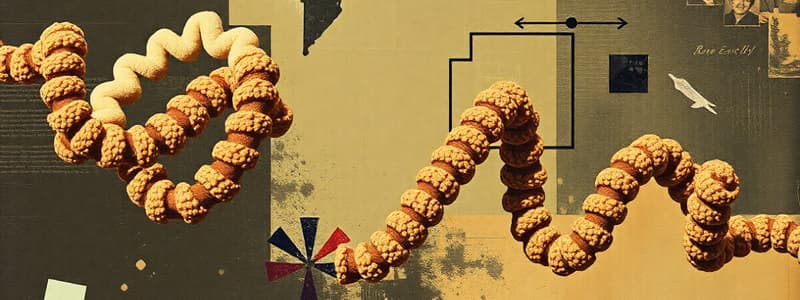Podcast
Questions and Answers
Which BLAST program is specifically designed to compare nucleotide sequences?
Which BLAST program is specifically designed to compare nucleotide sequences?
What describes the tendency of a molecule to cluster together and avoid water?
What describes the tendency of a molecule to cluster together and avoid water?
Which BLAST program is the fastest and useful for comparing large numbers of sequences?
Which BLAST program is the fastest and useful for comparing large numbers of sequences?
In protein structure, which forces primarily drive the clustering of hydrophobic amino acids?
In protein structure, which forces primarily drive the clustering of hydrophobic amino acids?
Signup and view all the answers
Which of the following BLAST programs is used to find distant relatives of a protein?
Which of the following BLAST programs is used to find distant relatives of a protein?
Signup and view all the answers
How do hydrophobic and hydrophilic groups behave in an aqueous environment with respect to protein structures?
How do hydrophobic and hydrophilic groups behave in an aqueous environment with respect to protein structures?
Signup and view all the answers
Which BLAST program is intended for comparing a translated nucleotide sequence to a protein database?
Which BLAST program is intended for comparing a translated nucleotide sequence to a protein database?
Signup and view all the answers
What effect does the presence of both hydrophobic and hydrophilic groups have on protein conformation in water?
What effect does the presence of both hydrophobic and hydrophilic groups have on protein conformation in water?
Signup and view all the answers
Study Notes
BLAST Programs
- BLAST is a program used to compare nucleotide or protein sequences
- Various BLAST programs are available, each designed for specific comparisons
- BLASTn compares nucleotide sequences
- BLASTp compares protein sequences
- BLASTx compares translated nucleotide sequences against protein sequences
- BLASTx compares translated nucleotide sequences
- BLASTn compares protein sequences against translated nucleotide sequences
- PSI-BLAST finds distant relatives of a protein
- MEGABLAST is used for large numbers of sequences
Hydrophobicity Prediction
- Protein primary structure dictates folding
- Protein shapes are formed by interactions among amino acids
- Interactions include hydrogen bonds, sulfide bonds, hydrophobic interactions, van der Waals forces
- Hydrophobicity is a key factor in secondary and tertiary structure prediction
- Hydrophobicity refers to a molecule's tendency to avoid water
- Hydrophobic molecules are less soluble in water
- In proteins, hydrophobic amino acids cluster together, away from water, forming a core
- This clustering affects the protein's shape and function in different environments
Studying That Suits You
Use AI to generate personalized quizzes and flashcards to suit your learning preferences.
Description
This quiz covers the various BLAST programs used for comparing nucleotide and protein sequences, as well as the principles of hydrophobicity prediction in protein folding. You will learn about different types of BLAST, such as BLASTn, BLASTp, and PSI-BLAST, along with key concepts regarding protein interactions and hydrophobicity. Test your knowledge on these essential topics in molecular biology.



